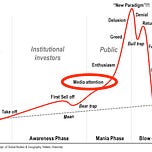In my most recent monthly issues, I’ve looked at the overall investment landscape and the unique risks and opportunities crypto offers. This month, I will challenge some popular expectations that seem to make sense but may not necessarily turn out the way people expect.
If the embedded audio narration isn’t working properly, tap this button to switch over to the podcast version.
Looking back at all of the monthly issues I’ve published since starting this newsletter in March 2020, I noticed a pattern: the embrace of uncertainty.
Some call this 50/50 analysis. To be fair, I’ve lost count of how many times I’ve said “we shall see” or “time will tell.”
In crypto as in life, nothing has to happen the way you expect.
YouTube, Twitter, and Reddit may say otherwise. While that certainty may feel good, you pay a high price for a cheery consensus—and an even steeper price for a faulty assumption.
History is full of decisions that seemed good at the time and ended poorly, and decisions that seemed stupid at the time and ended well. We pass judgment in the moment, but time dictates our fate.
As an investor, you can’t wait for certainty. Especially in this market. Everything moves too fast.
If you wait for the market to confirm a bullish bias or negate a bearish bias, you risk missing out on an amazing investment opportunity. If you wait for the market to confirm a bearish bias or negate a bullish bias, you risk watching prices go up forever, without you.
Fortunately, we have history and hindsight from which to draw inspiration. Some people love fractals. I prefer to look at the entire 12 years of bitcoin’s history for trends and patterns that persist over time. Coincidences on their own, correlations when combined, expectations when they match our present situation.
When you step back and look at the big picture, you can see clearly how the momentum in the market shifts over time. While that doesn’t tell us anything about the future, it can help us plan, prepare, and trust that if we plan and prepare well, we will be ready for opportunities when they present themselves.
It’s ok to fear uncertainty. Better if you can act decisively in spite of it.
As long as they spell the name right
Over the past several months, headlines proclaimed FUD over China’s miners, US crypto laws, Tether, fraud, fines, and bear markets. Elon Musk called Dogecoin a hustle on Saturday Night Live and Tesla said bitcoin’s bad for the environment.
Meme coins grace the front page of the Sunday Business section of the New York Times. HNWI mainstays like Wall Street Journal, Luckbox, and Economist publish regular coverage of crypto. CNBC covers crypto all the time.
My old boss—a former lobbyist—sends me crypto articles on the regular.
(Ok, boomer.)
It reminds me of something Dale Carnegie wrote:
“Nobody kicks a dead dog.”
Every bit of coverage, even negative, proves cryptocurrency is still alive and kicking. As the media people say, there’s “public interest” in covering it. It gets clicks. It sells.
And that is all it needs to do. When the media talks about crypto, that raises awareness. It makes people pay attention.
For people who don’t like crypto, it confirms what they already believe. Nothing changes.
For people who might otherwise not even think about crypto, each mention makes it seem more legitimate, real, and worth thinking about.
Some of them will still not care.
Most will shrug and ignore it. “Oh, there’s that bit-money thing again.”
A few will look into it further.
Once prices go up long enough for people to think prices will keep going up, or high enough that somebody writes an article about how everybody’s getting rich, those people will start buying.
They may even call or text you about it.
And after they buy, the shruggers will follow. “Sure, I’ll throw a few shekels in. You never know, right?”
If history is our guide, we will then get another parabola. That parabola will break. Many people will give up. Some will stay. The cycle will start again—as it has for the entirety of crypto’s history.
Next stop mania?
Some people will take this as an opportunity to claim the next stop is a supernova. They’ll say we reached the “media attention” stage after a bear trap, as shown in the famous “Anatomy of a Bubble” chart:
That’s a fine model and certainly possible. This version may do better:
In other words, one bubble cycle after another for years. At any time, it’s impossible to tell if you’re in a bear trap or capitulation, mania or a return to the mean.
As a result, extreme moves should not phase you. Bitcoin’s price can drop 30% this month and still not break the upward trajectory it started in March 2020.
Some predict it will do just that. A-B-C correction, death spiral, dead cat bounce, bear market, etc. If that happens, altcoins will do worse.
After all, the market has to revert to the mean at some point, right? We started the year with a parabolic move. Obviously, this market finished its “bull trap, return to normal” phase, and it’s all downhill from here.
The problem is, when you look at the whole of history, the “mean” is probably higher, not lower than today’s price.
For reference, this black line is the logarithmic mean:
In this chart, the black line is the arithmetic mean:
Do you see what I see?
Both black lines are above today’s price. If bitcoin reverts to the mean, its price will go up.
Does that mean mean anything?
No, it’s just an arithmetic average of prices since bitcoin’s creation. Change the timeframe and you’ll get a different result.
My point:
Every upswing looks like mania. At any moment, you can’t know where you are in the market cycle.
When you look at 2021 trading and on-chain data, April’s $65,000 bitcoin all-time high looks nothing like previous market cycle peaks. It’s been years since we’ve seen any of the signals we saw during previous market cycle peaks.
What makes you think we have to start now?
Extreme is normal
Some will take a big upswing or downswing as confirmation of a trend or shift in trend.
Perhaps in normal markets, you could make that conclusion. Crypto is not a normal market. Its “normal” movements seem outrageous.
In the stock market, a 5% swing forces Aunt Sally and Uncle Morton to swap their Apple stock for 5-yr T-bills “before the market collapses.”
In the bond market, a 5% swing could spell catastrophe for the world’s debt markets. Fortunes gained or lost, pensions made insolvent, countries on the verge of collapse, and financial pandemonium.
In crypto, a 5% swing can happen between the time you go into the bathroom and when you come out of it.
We know based on history, the range of expectations is massive. According to data models, bitcoin’s price can go as low as $9,600 or as high as $288,000. Quite a lot of ground to cover.
You don’t have to pin your hopes on a supercycle or stress about a bear market. You already did that.
Now it’s time to relax, let the market go wherever it wants to go, and set aside fresh cash or cheap credit for the next opportunity. Follow my plan and you’ll know when that opportunity comes—possibly sooner than you think.
Some prefer to dollar-cost average. That’s a good approach. My plan does better.
For example, if you had bought $250 worth of bitcoin every two weeks (payday) since January 1, 2017, right at the start of the 2017 parabolic bull market mania, you would have 2.36 bitcoins today, more than four years later.
With my plan, you would have saved that money for whenever bitcoin reached the buying zone of my plan. In doing so, you would have reached at least 3.02 bitcoins by September 2017.
In nine months, you would have accumulated more bitcoin than in over four years of dollar-cost averaging, possibly with as little as three purchases.
From March 30, 2021, when I published my plan, DCA gives you .32 BTC today. Under my plan, if you only buy bitcoin when its price entered the buying zone—usually the highest price my plan tells you to buy at—you would have .49 BTC today, and you would have bought no bitcoin for eleven of those months. You’d still come out ahead of DCA.
Depending on the exact price and amount you bought, you’d have as much as twice that. That’s a lot of free bitcoin for saving your money until my plan says to buy, rather than dollar-cost averaging.
Enough for a Lambo?
Maybe, maybe not. The goal is not to cash out, but to build wealth with as little time and effort as necessary. No trading or taking profits.
Lots of people will do better than my plan, but I’m content with the results.
Earn yield while you wait for the next opportunity
What do I do with the cash I’m saving from not dollar-cost averaging?
I convert it to stablecoins and deposit it into high-yield crypto savings accounts. That way, I earn 7-12% while I wait for the next opportunity to buy crypto.
Try it for yourself! I created a list of platforms that give you some crypto for doing what you’re already doing—HODLing. It covers the six platforms I use, not all of the amazing businesses that offer the same types of services.
Tap this button to see the list.
Wen moon?

If history is our guide, we can expect this bull market consolidation to end in 1-3 months. That means new all-time highs as early as next month and as late as November.
Yes, that means it could take three more months for bitcoin’s price to get back to $65,000. That would fit the timeframe of previous consolidations before the next leg up.
On the other hand, this market tends to do the opposite of what you expect. While the trading charts suggest we broke some bearish trends and the on-chain data looks a lot like what we see at the start of strong runs, let’s not get ahead of ourselves.
When the range of realistic prices falls anywhere between $14,000 and $120,000—and the data models predict anything from $9,600 to $288,000—you can’t take anything for granted.
For altcoins, the range is even wider.
Along the way, sellers will come out in droves whenever prices move too much, too quickly in either direction, up or down. Usually, you can shrug off a 30% downswing—but sometimes, it marks the start of something worse.
It’s hard to be certain about these things, but it’s not like the wider world offers any more certainty. If anything, it’s more uncertain than crypto.
Inflation or demand shock?
For example, the cost of everything’s going up. Some say that’s from inflation.
Seems like a safe bet—after all, when you throw all that money into the banking system, it’s bound to hit the real economy at some point.
How much of those rising prices come from inflation as opposed to disruptions in global supply chains?
Demand for durable goods and commodities has far outstripped supply, producers and shippers lack enough workers to fill their orders, and ports are clogged and backlogged.
Crucial jobs remain vacant, key electronics components remain scarce, and US and China trade policies continue to undermine global commerce. COVID-19 restrictions don’t help.
Some laughed when the US central bank called inflation transitory. Maybe the Fed has a point?
To get true inflation, we need to see a rise in the velocity of money—more money chasing after the same or fewer goods and services.
We don’t see that. In fact, the velocity of money is going sideways after falling for years. Take a look:
That means money isn’t moving through the US economy fast enough to produce inflation in the conventional sense.
Before we can say with certainty that these rising prices are truly inflation, not a demand shock, we need to see how the markets adjust. That will take time.
Already, people have shifted to alternative sources of building materials or delayed construction projects. Commodity prices and input costs have dropped since the beginning of the year. At the same time, transportation networks have expanded capacity and customers have started shifting to new materials and technology.
Since the beginning of the year, I’ve heard from business owners and seen news reports about rising wages. Yet, I still see labor shortages everywhere.
Some blame generous government unemployment benefits, but it’s also possible that in the post-pandemic era, people can make enough money gigging or working from home rather than working for somebody else. Or maybe people just don’t want to move for work or commute anymore—especially for work that’s physically difficult, boring, dangerous, or annoying.
From what I can see, the vast majority of vacancies are exactly those types of jobs. Retail, food services, transportation, and construction. Why suffer angry customers, shitty bosses, low wages, bad working conditions, risk of injury, and incompetent coworkers when you can pick up a gig job, contract for a remote work assignment, or start an online business?
Even if the US government reduces or eliminates unemployment benefits, that may not bring people back to work. Some jobs just suck too much. It doesn’t matter how much you pay, people simply won’t want to do it. They have better alternatives.
What if restaurants start closing or cutting back their hours because they can’t find enough workers? What if businesses automate more of their services? Sure, machines cost more upfront, but their costs rise little over time (and often go down). Humans cost nothing upfront but their costs always go up over time.
What happens when people cost so much more than machines that businesses have to switch just to keep their doors open? If rent, mortgages, and household debt keeps eating away at inflation-causing discretionary purchases? What about the ripple effects on other sectors of the economy?
Or if China, with a near-300% debt-to-GDP ratio, has some financial problem that sucks stimulus and capital out of the world’s markets?
It’s hard to get inflation when input costs go down, money gets trapped in financial markets, and the world’s second-largest economy cuts back on stimulus.
You need to plan for inflation. After all, all the major central banks are trying to generate inflation all the time. It’s one of their two responsibilities.
Just make sure you’re not screwed if this demand shock subsides and prices go down again.
Governments can’t stop this train (yet)


In my 20s, I worked in Congress and lobbied for a Fortune 500 company.
(Not at the same time.)
Now, I’m a civil servant.
I don’t know how things are where you live, but in the US, our government is very complicated. Every legislative concept goes thru many twists and turns before it passes into law (if it ever does). Even then, it can take more twists and turns on its way to implementation.
And after all that, nobody knows in advance how things will go. Often, Congress appropriates too little money to actually implement the laws (sometimes, by design). Other times, US regulators don’t have enough staff or know-how to enforce the law at all. In a few cases, the laws are simply impossible to enforce or blocked by court action.
And each time the leadership changes, you never know what the new leader will care about.
We can’t do much about the regulators. The US political system limits our ability to influence the people who run the bureaucracy.
There are no such limits on our ability to influence Congress.
For every law that threatens to harm the growth of cryptocurrency, we have people working to fight it. Often, well-funded, well-connected, talented, hard-working people who know how to work the political system.
Who’s to say they can’t succeed? We have allies in Congress.
Some fear governments will crush cryptocurrency. I’m not one of them.
China kicked out miners and banned crypto for the zillionth time. Fundamentally, nothing changed.
Turkey banned crypto payments. Nigeria banned conversions of fiat to crypto. Qatar, Bangladesh, Ecuador, and many other countries banned all crypto.
Yet, the market continues to grow. The technology continues to flourish.
Basel 3 jacked up reserve requirements for banks dealing in crypto. I’m certain the banks will happily comply if they can make enough money offering crypto-related services.
And you’re worried because one chamber of US Congress passed a probably-unenforceable provision that won’t take effect until 2023?
Crypto is borderless, permissionless, and accessible to everybody, everywhere, all the time. All you need is a laptop or a mobile device and a little know-how. There is no way for governments to stop that, and it will take years for the world to cobble together a regulatory framework that does anything more than whack-a-mole.
Keep in mind, Binance runs a $500 billion company without a headquarters or regulatory jurisdiction. In some parts of the world, you can’t even do business with them. Financial institutions severed ties with the platform en masse earlier this year.
Yet Binance is still growing. Some say it’s stronger than ever.
Maybe over time, slowly, as the market consolidates around a few on- and off-ramps, a few killer apps, and a few blockchains, governments will have an easier time controlling crypto.
That could take years.
On the list of crypto risks that keep me up at night, governments fall somewhere around the middle of the list. I’m far more worried about hackers, global debt markets, war, and my own incompetence.
COVID-19 resurgence—this too shall pass
Some worry that COVID-19 will lead to another financial panic or worse. Some of you already live under lockdowns and many of us have some sort of restrictions as the result of local laws and ordinances related to COVID-19.
That’s not a political statement, just an observation.
None of it seems to matter for crypto.
Even during the lockdowns of spring and summer of 2020, crypto grew.
Small consolidation if your government has taken measures you oppose. Officials will have to answer to their citizens and possibly their courts regarding their actions and any laws or regulations they create. I’m not going to get into that, but I will give you a reason to expect COVID-19 will matter less and less to our social, financial, and economic fortunes over time, contrary to what many people believe.
Why?
Because the vaccines work and more people are taking them.
Whether you believe these people are sheep or heroes, the data shows high vaccination rates lead to low rates of death and hospitalizations. Low vaccination rates lead to more deaths and hospitalizations.
I realize people disagree over whether people should take vaccines and what social, epidemiological, and moral issues go along with it. The media offers contradictory data and generally no context through which to interpret that data. Our politics seem constantly at odds with science.
At the end of the day, vaccines keep people from getting sick and dying. Not everybody, everywhere, all the time, but enough that many unvaccinated people want to take them.
As a result, vaccination rates keep rising pretty much everywhere vaccines are available. People know they’re far less likely to get sick and die after they get vaccinated, so they get vaccinated.
Does that mean I think you should get vaccinated?
No, that’s your decision. It’s none of my business.
As enough other people get vaccinated that they feel sufficiently protected from COVID-19, it won’t matter whether you get vaccinated or not. Few will care about your welfare enough to suffer even the slightest inconvenience on your behalf—just as they don’t care if you get the flu, cancer, or run over by a truck.
Some will even say it’s your fault.
Once enough people see COVID-19 as somebody else’s problem, it will stop being a public health emergency. It will just be another disease. Life will go back to normal.
When will that happen?
For many people, it already has.
Can that change? Of course. COVID-19 evolves constantly. So do people.
Is it possible a new COVID-19 variant could throw everybody for a loop? Yes. Everybody’s bracing for a new, unknown strain that could emerge at any time.
Could we get a new pandemic from a different disease? Yes. New diseases appear all the time and many existing diseases can evolve into pandemic threats.
Is it possible COVID-19 will cause intermittent lockdowns, travel restrictions, and economic woe for the foreseeable future? Or maybe forever?
Sure.
As long as vaccination rates keep going up, I wouldn’t bet on it.
No selling until we have to
For now, the crypto market’s rising again. Let’s hope it continues to do so.
If you’ve followed my plan, you’re somewhere between even on your investment or up as much as 800% as of August 26, 2021. With altcoins, it may be higher or lower depending on what you bought, when you bought it, and the price you bought it at.
At some point, the market will get so heated, so full of people looking to make money as fast as possible, so dominated by sellers that we’ll have to exit to protect ourselves from a “blow-off top” and a 2-3 year bear market.
We’re still a long way from that. As a result, I’m not even thinking about an exit.
Taking profits? Even worse.
Our goal is to build wealth with crypto. We can’t do that if we sell, and we only sell when the market forces us to, purely as a defensive measure.
And if that never happens, all the better. But that almost happened earlier this year.
In February, the market was on a trajectory to hit a cycle peak within months. In March, I published my exit strategy in case we saw the “sell” signals in my plan.
At that time, only a big crash or several months of sideways price action could have kept us from hitting a market cycle peak.
Fortunately, we got exactly that.
Now, the market’s in a totally different place. Some metrics have already reverted to the healthy levels we saw in the fall of 2020, before most of you entered the market. Other metrics have turned from bearish to neutral.
On-chain data shows a clear shift from a market full of sellers to a market full of buyers. My own financial advisor bought bitcoin in May. I’ll bet you know a lot of people who have a little bitcoin, but they’re not telling you because they’re embarrassed or worried it might not work out.
Taking money off the table now is like quitting a marathon after the third mile. I’m not saying we’re going to cruise into a supercycle, but there’s a lot more race to run.
Of course, people will take profits on the way up and panic-sell on the way down. Let’s not get ahead of ourselves with data models, moon shots, and discount portfolios.
Let’s also not psyche ourselves out with FUD and bearish trading patterns.
Since April, this market has moved from weakness to strength. Now we just need bitcoin’s price to go up long enough for people to think it'll keep going up. Once that happens, everything else will fall into place.
When will that happen?
Nobody knows. This is an uncertain market.
Accept it. Embrace it. Because that uncertainty is the reason we have this opportunity.
Relax and enjoy the ride!















